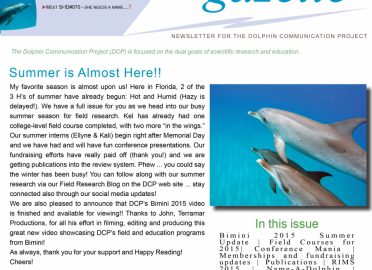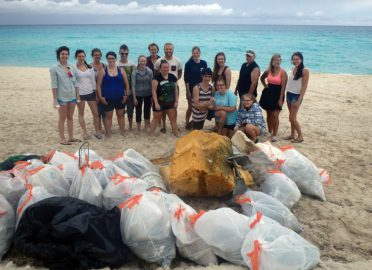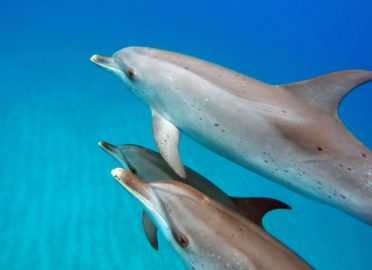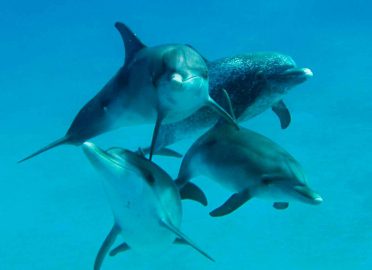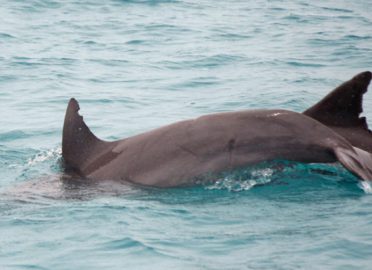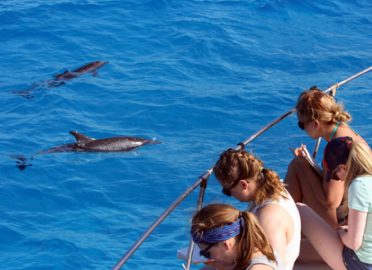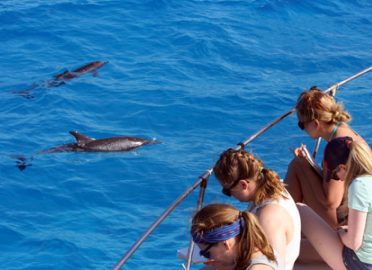The Dolphin Gazette, Issue 19.2
It's here! It's here!
Click here to download your copy of the latest Dolphin Gazette. Updates on our analyses and pending scientific papers are just a small part of this issue.
The day was looking stormy…
Tuesday was a busy day!! Soon after breakfast, we headed to Radio Beach for UNBSJ’s annual beach clean-up. We were grateful for this opportunity to give back to the island that has been so welcoming (and, unfortunately, on which we are leaving lots of trash). We collected a lot of garbage, separating what little can be recycled here. Back inside, we brought our week full circle with a discussion on ecotourism.
Bye UNBSJ!
On Wednesday we all rose early as usual. The UNBSJ students packed up their things and we all had our final breakfast together. The water taxi came to the Sea Crest Hotel at 9:30 AM to take the students to the airport. They were unfortunately delayed at the airport for a few hours but they did arrive safely in Miami. Kathleen was even waiting to greet them upon their arrival in the US! They had been hearing about Dr.
DCP’s 2015 Bimini Video
DCP is pleased to share with you our breathtaking new video showcasing our research at Bimini, The Bahamas. Produced by Terramar Productions, our 2015 Bimini Video introduces you to the dolphins around Bimini, as well as the scientists studying them. Kathleen and Kel both make an appearance, as well as a number of our colleagues and collaborators (and students) and of course our Adopt-a-Wild Dolphins! DCP welcomes a number of secondary level and college level students from a variety of schools to Bimini each year.
Bottlenose! They exist!
After breakfast, we did more paper presentations: dental erosion in south Atlantic dolphins, vocalizations of dolphins off Bimini (w/ DCP data!) and characteristics of morphotype D orca whales. Next, we had a Skype presentation from Dr. Justin Gregg. He asked the question, “Are dolphins intelligent?” We learned about many different experiments, including ones that definitely do not happen anymore! After a few references this week, we all know who John Lilly is (enthusiastic nods). We found dolphins’ ability to mimic and the potential uses of their signature whistles cool.
Our search leads us to the Sapona
Our morning classroom session included paper presentations; each one of us had to find a dolphin-related scientific research paper and present it to the class in layman’s terms. Those who presented today were all on behavior: infant carrying, sighting locations & social interactions, male reproduction behavior and dolphin behavior around gill nets. After some serious sandwich making, our boat trip departed early – 11:30. We headed in the normal direction, but the rough seas had us turning back to shore for lunch. Anchored near the beach, we eat and swam a bit, before resuming our search.
Third day not the charm
Sunday morning began with another round of research paper presentations. This time, students covered behaviors of bottlenose dolphins around two dead conspecifics, spatial and social-sexual segregation in bottlenose dolphins and the hypothesis of diving limiting brain size. Next, we were joined by Dr. Kathleen Dudzinski via Skype. She told us cool things about sounds themselves and dolphin acoustics. We discussed the frequencies that are out of our hearing range and the importance of having the right recording equipment.
Sick, snorkeling & dolphins
We saw dolphins!! But first, we our brains were a bit foggy during breakfast and then we loosened up during a lecture on photo-ID: identifying study subjects by species, sex, age and individual. It was interesting to see the different ways to estimate a wild dolphins’ age. Spotted dolphins are handy with their age spots! It’s helpful to look for multiple identifying characteristics, so that you aren’t relying on just a noticeable fluke or dorsal fin.
Sick, snorkeling & dolphins
We saw dolphins!! But first, we our brains were a bit foggy during breakfast and then we loosened up during a lecture on photo-ID: identifying study subjects by species, sex, age and individual. It was interesting to see the different ways to estimate a wild dolphins’ age. Spotted dolphins are handy with their age spots! It’s helpful to look for multiple identifying characteristics, so that you aren’t relying on just a noticeable fluke or dorsal fin.
Food, Glorious Food
Hi all!
We are thrilled to welcome the 2015 crop of students from University of New Brunswick Saint John (UNBSJ) and their Professor, Stephen Turnbull, to Bimini! Over the next week, we hope you enjoy their field reports. Here’s the first installment:
Those of us, who had finished up our course at the SharkLab, cleaned our rooms, packed up & took a group photo (including canine Kahli!). We said goodbye to our classmates who were not joining the dolphin course, and headed to the water taxi.

